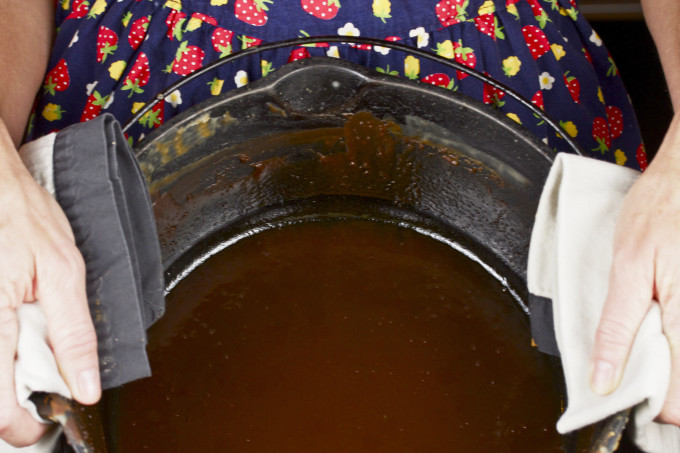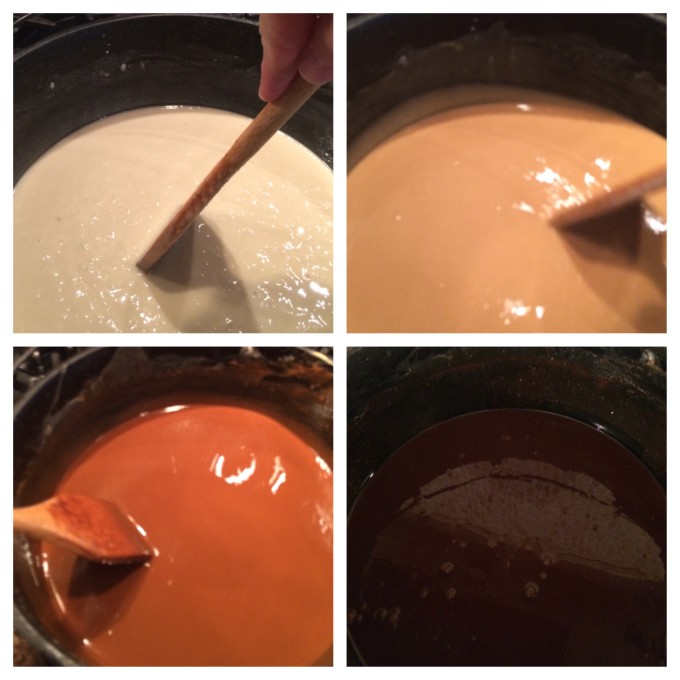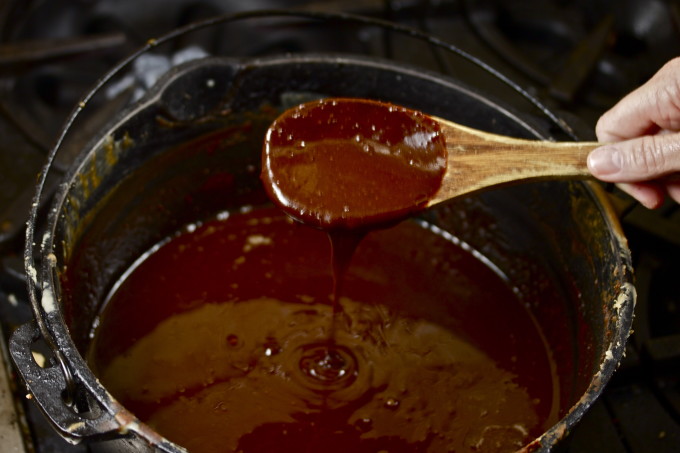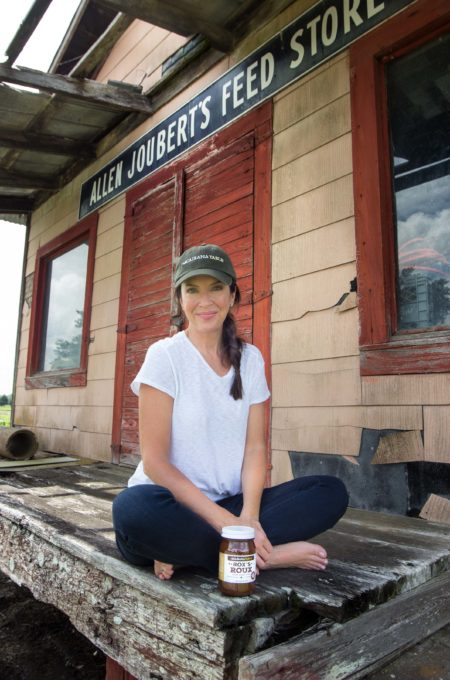If you ask me, a dark Cajun roux is the secret ingredient that is the single most important building block of Cajun cooking. So important, that for your convenience, we developed a jarred product we call Rox’s Roux–the deepest, darkest, and richest commercially available roux. This product will add consistency and quality to any Cajun roux-based recipe.

Roxanne Graham and her Rox’s Roux. (All photos credit: George Graham)
So, what’s all the fuss about a Cajun roux? To find out, we urge you to make a roux from scratch and discover the lost art of roux-making, a roots cooking technique essential to Cajun and Creole culture. My wife Roxanne will show you how in a step-by-step video that will give you every one of Rox’s roux-making secrets. Take a look by clicking below.
Making a dark Cajun roux from scratch is a dying art. Not too many years ago, there wasn’t a Cajun or Creole household in South Louisiana that didn’t have the unmistakably intense aroma of a dark roux, in all its glory, wafting through the kitchen. Home cooks were taught basic roux-making skills early on, and it was a rite of passage to pass it on to the next generation.
Times have changed.
With the proliferation of jarred and powdered roux products, as well as packaged gumbo mixes, the art of roux making is slowly dying off. Don’t get me wrong, some prepared roux products like Rox’s Roux are very good, and I use them myself. But, there is no substitute for the ritual of making a homemade roux from scratch, and I believe it is the obligation — no, responsibility — of roux makers to hand down this timeless artisan skill to their children. I know my wife has.

The dark abyss of a perfectly made Cajun roux is the depth of flavor in Rox’s Roux.
Rox can make a roux.
As deep and dark as blackstrap molasses and just as rich.
My wife Roxanne doesn’t cook every night nor does she profess to be a culinary artisan, but she is one of the best natural cooks I know. For her roux, she follows a strict set of guidelines handed down from generations of good Cajun cooks before her. She was born and raised in Jennings, Louisiana, and I sometimes tease her that her grandmother’s black iron pot and well-worn, wooden gumbo spoon were her dowry. Truth be told, to her they are significantly more valuable than anything money could buy.
On a cold January day, she can work magic in that pot with a roux-infused chicken and sausage gumbo like none other I’ve tasted. A roux is the foundation on which gumbo is based. Rox’s roux is nursed and nourished with a serious attention to detail that defies logic. It’s as if my wife goes into a semi-lucid state of consciousness that is mesmerizing. She stirs and stirs. And focuses on color, texture and smell. For over an hour, she stirs. No phone calls, no conversations, no distractions whatsoever.

White, cream, beige, tan, brown, mahogany, and beyond.
There is an instinctive point of departure — a point of no return that she pushes beyond. A less brave or sure-handed cook would stop short of perfection. She has the confidence and courage to pursue that hauntingly dark depth of a rich chocolate-colored roux. Hershey bar chocolate is the terminus, and anything more is burnt and destined for the disposal.
With her wooden spoon scepter in her right hand, my gumbo queen rules the kitchen.
- 3 cups all-purpose flour
- 3 cups oil, such as vegetable oil
- A Cajun roux starts out in a large cast iron pot over medium heat. With no distractions and approximately one hour of time at your disposal, begin by adding the flour and oil.
- With a long-handled wooden spoon, begin to stir. Constant stirring and moving the flour around the bottom of the pot is the key to browning the flour evenly to prevent burning. This early stage will go slowly as you begin to see the white flour take on a beige and then a tan color.
- Continue stirring slowly and evenly, scraping the bottom and the circular crevices of the pot to move the flour around in the hot oil.
- At about the half-hour mark, you will begin to see a brown color developing and smell the first hints of toasted flour. This is where the stirring becomes even more crucial.
- At this point, you begin to enter the quickly developing phase where the least bit of inattention could result in burnt flecks of flour appearing – a sure sign you’ve ruined the roux. Watch your heat and lower it if the roux is cooking too fast.
- Constant stirring to keep the flour from staying in one place too long prevents burning. You will begin to smell an even nuttier aroma as you see the color turn darker mahogany. Most stop here, but you will keep going until you achieve a deeper, darker chocolatey consistency and color.
- Forget time at this point since you are now cooking by instinct, sight and smell. The utmost attention is needed to your stirring, and when you see that Hershey chocolate darkness, you will know you have arrived.
- Turn off the heat, but continue stirring until it begins to cool down and quits cooking.
- Spoon the roux into a bowl and let cool.
YOUR SEAT AT THE TABLE: If you like this Cajun cooking story and Cajun recipe then accept my personal invitation to subscribe by entering your email at the bottom or top right of this page. It’s quick, painless, and FREE. You will receive an email alert and be the first to see when new Cajun cooking stories and Cajun recipes are added. Thanks, George.



I have given up on trying to get a good dark roux in Canada to do justice to your mouth-watering recipes. Until we can travel to Louisiana and do some back road tours for some real Cajun, thanks for sharing. It’s going to be a busy few days before we host an Acadian/Cajun feast this coming weekend.
Hey Hank – Just go to our STORE here on our website and order my wife’s Rox’s Roux, the deepest, darkest, richest roux you can buy. We’ll send you 3 jars to make a delicious gumbo and many more recipes. All the best to my new Canadian friend.
I found this roux during this past year. Been making the same kind myself since learning in my 20’s to make gumbo. However, being from TX, I learned by taste and becoming a better cook over time, to make a very dark roux. I am now 75 and have spent over a year trying to recover from injury and bone disease which makes it impossible for me to make my own nice DARK roux as I can’t stand and stir that long. I’m so grateful to Roxanne for sharing roux that tastes like my own. I can now have gumbo again and the grandkids are excited too! Thank you for this amazing product.
Karla- Thanks for the heartfelt comment, and I will pass along your beautiful words to my wife Roxanne. All the best.
I just started making my own roux. But I’m still a little timid to push it the deep chocolate color. Thanks for the recipe. I’ll keep trying.
I like the passion you wrote into the recipe, and will be trying it soon. To-date, my roux’s have been simple (blonde, butter+flour), but am now diving into the darkness.
One thing I would love to see added, is how to USE the dark roux. The internet seems devoid of any advice in this area. It seems well-known that as roux’s darken, the thickening ability decreases so you need to use more roux, but am I supposed to double my usual amount of roux? Triple?
Hey CO- Thanks for the great comment. In Cajun cooking, a dark roux is for much more than just thickening; the boost of flavor is mind-blowing. To find great recipes, just go to my website at AcadianaTable.com and add the word “roux” into the “search this website” box on the right-hand side of the page. You will see a bunch of roux-based recipes to try. As for the amount of roux to add, all dishes are different and the ratio is dependent on the quantity of liquid (stock or water) that the recipe calls for. Follow my detailed recipes, and you can’t go wrong. All the best.
100% percent: The best gumbo for my taste buds is with a dark, dark roux. I’m grateful to find this lovely recipe. I’ve made mine by instinct similar to this and have often said to take if off the stove just before it burns. Your recipe solidifies that I’m a full-blooded Louisiana girl, once removed.
I moved to Louisiana at age 11 and studied French from middle school through CODIFIL and beyond in college. From this 1/4 Lebanese, 1/4 Cherokee, 1/2 WASP, 61-year-old living now in Memphis, thank you for making my heart remember where it belongs.
Hey Kim- What a sweet comment! So great to see that your roux-making skills are alive and well in Tennessee. Be sure to pass your culinary knowledge on to the next generation; it is important. All the best.
I’m 68 out of Arkansas. You say it just like my grandmother and great grandmother.
You’ve got to cook that flour until it is ALMOST burnt. It doesn’t matter if you’re making roux for gumbo, or just plain ole gravy for the Sunday dinner of fried chicken and mashed potatoes.
The darker the better, but the real secret it to know just when to stop.
Seafood gumbo cooked today and Crawfish Étouffée will be tomorrow’s project.
Laissez le bon temps roule!
I have a tendency to push the heat higher than it should be, but right before it turns to toast, I dump the trinity in and somehow manage to save it, just been kinda my thing. I’ve tried a few different methods, but about 30 minutes is all I can handle, so I’ve never tried to make enough to save for later.
Hey Bobby- You’re like me: lack of patience. That’s why Rox is the roux-maker in our family. All the best.
My favorite cooking is Cajun/Creole. Been doing it for many years.
This Carolina girl learned the art of roux from her Cajun mother-in-law many years ago. I still have her gumbo recipe (she said it made my babies prettier). Now I make it for the family. Glad to keep it going.
Hey Marie – Handing down these traditions to the next generation is admirable. All the best.
I’ve been making it this same way for 65 years, when my grandmother taught me at age 10. Unfortunately I haven’t lived in LA Since age 18, so it’s difficult to impossible to find a lot of the fresh ingredients that were so accessible there. I still get people asking me how to make a gumbo, etc. I always tell them they have to make a roux first. Then I explain how, and young folks fade away–seems no one really wants to learn how to cook. I always cooked everything from scratch, nothing canned or processed.
What temp is her burner making the roux?
Hey Greg- Begin the oil and flour on medium heat, and while it cooks quickly, you will begin to adjust the heat down as it goes through its different color stages. In the final dark stage, your heat should be at a low simmer. After you do this a few times, it will come naturally to you. Happy cooking!
There are a few of us out here… The Remnant… still stirring. Just one more Abita oughta do it.
Hey Papa- Great comment! Keep stirrin’ and share your technique with others. That’s the only way we can keep the tradition alive. All the best!
Just need a good crawfish etouffee recipe.
Hey Larry- Here you go: https://acadianatable.com/2023/02/20/crawfish-etouffee/
All the best.
When I make chicken & sausage or andouille gumbo, I use bacon grease for my roux instead of oil. The bacon grease coagulates on top in a hard shell with the rendered grease of the chicken fat, sausage, etc., and I pop it right off the top the next morning with a flat spatula. I’m glad to know where to get a good dark roux from though, if I need it, especially for a more delicate food gumbo. How long does it stay good in the jars? I assume you have to refrigerate the jars.
Hey Gina- Any type of fat (even hog lard) will make a roux when cooked with flour. The only reason I use a neutral oil like vegetable oil is that the flavors of my ingredients will shine versus the flavor of the oil. If you like the taste of bacon (who doesn’t?) then I salute you with your creative approach. As for storing roux, both oil and flour are shelf stable ingredients that do not require refrigeration, and the same is true of jarred roux products. But if you feel more comfortable parking your leftover roux in the fridge, it is perfectly okay. Some folks say that roux is fine to use for up to three years, but I don’t have that problem since I go through it quickly in my kitchen with a multitude of uses. All the best.
I am from Baton Rouge LA. I now reside in North Texas. I always make my dark roux with duck fat for my chicken and sausage gumbo.
Hey Wayne- There is flavor in duck fat that will add to your gumbo. I’ve used hog lard but never duck fat. I will try it soon. All the best.